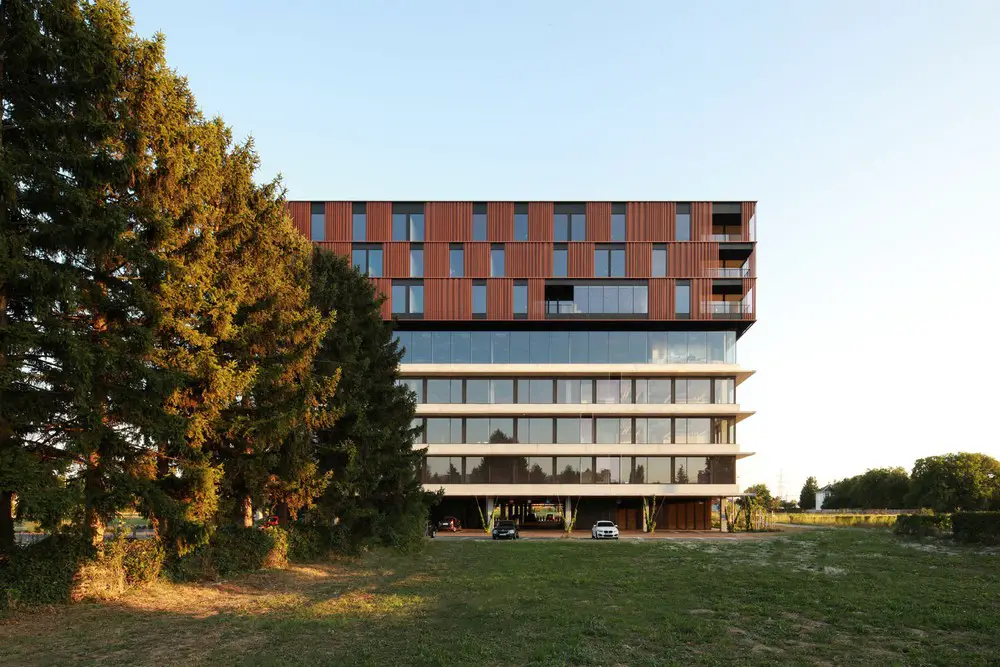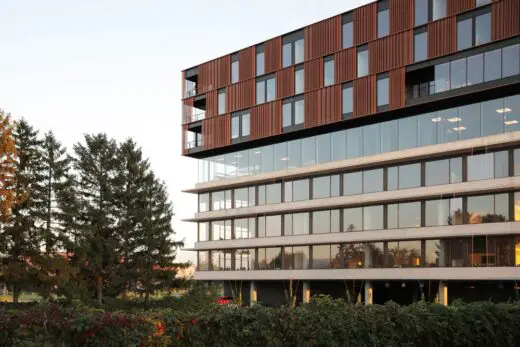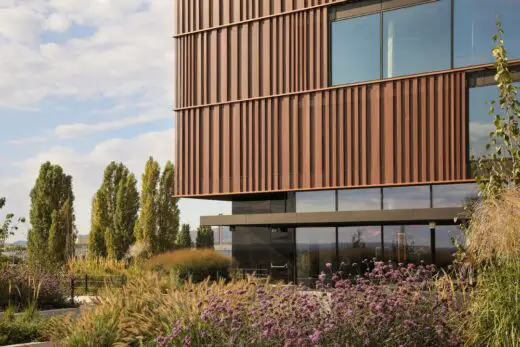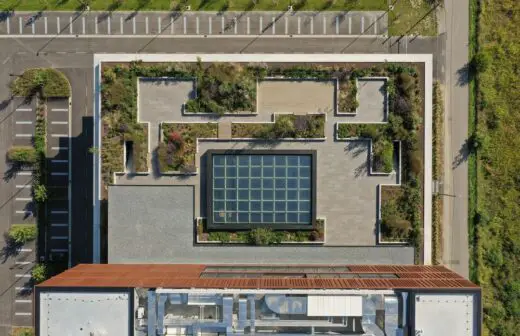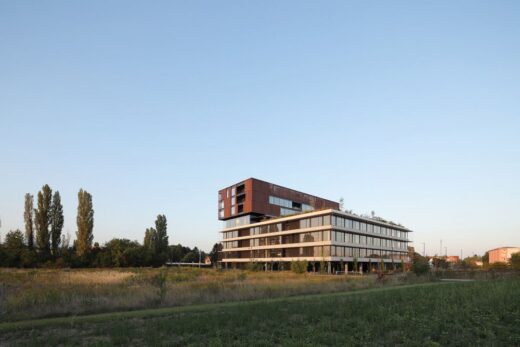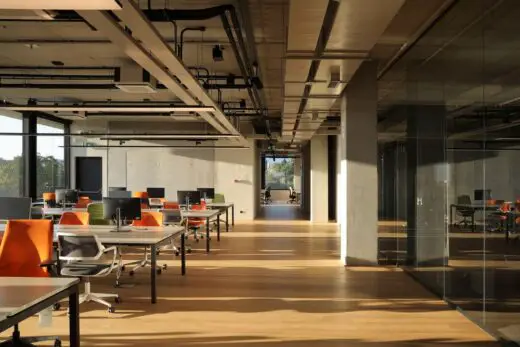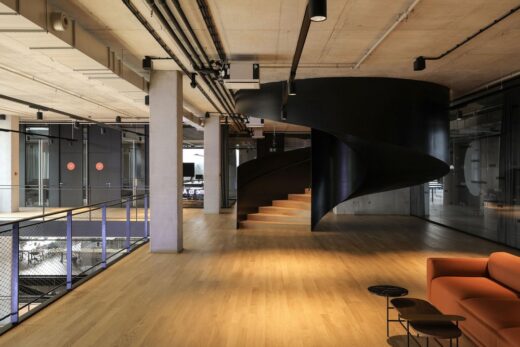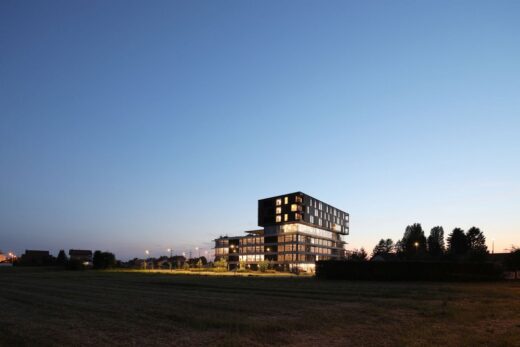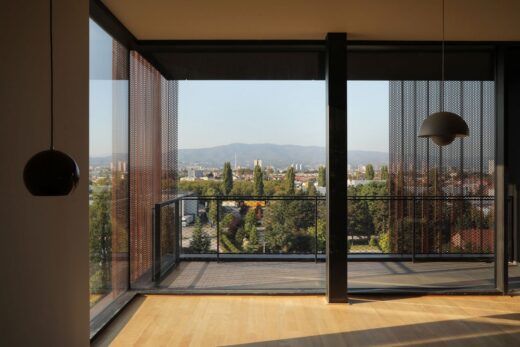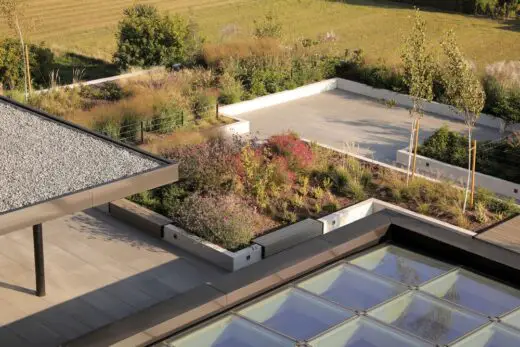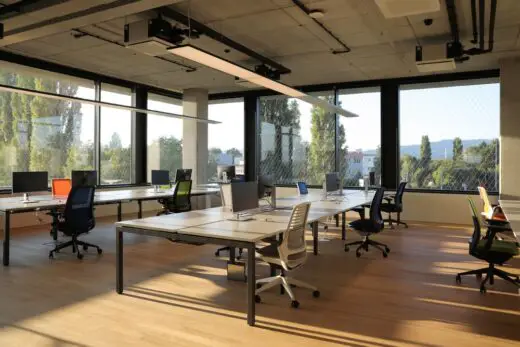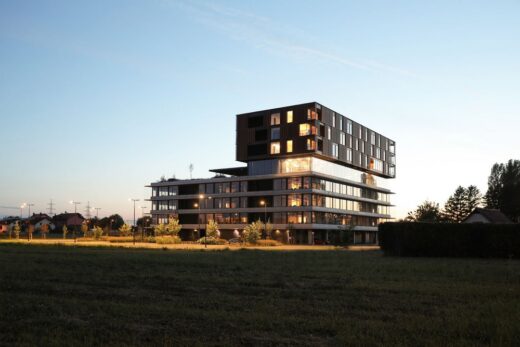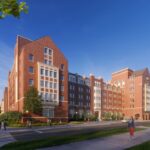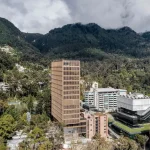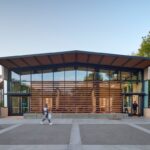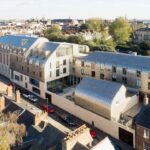Campus Infobip, Zagreb Housing, Croatian Residential Architecture, Flat Interior Photos
Campus Infobip in Zagreb
18 Apr 2022
Location: Zagreb, Croatia
Design: 3LHD architects
Photography: Jure Živković
Campus Infobip, Croatia
Infobip is a unicorn IT company based in Vodnjan, Istria, where it also built its first campus. The company’s rapid growth has spawned the need for a new hybrid building in Zagreb. Infobip is located on a plot on the southern edge of Zagreb, in a rurban zone bordering New Zagreb, directly next to the corridor of the newly planned avenue that will, once it is built, run along the southern edge of Zagreb. The zone is an entropic and poorly regulated area with low-rise medium-density multi-dwelling buildings lacking both an articulated public space and nature.
The campus is hybrid in character in several ways. The investor requested that, in addition to the offices, a residential section be created for employees and guests, as well as other accompanying facilities such as a conference hall. Also, this prestigious investor’s campus with highly qualified employees had to compensate for all the shortcomings of an environment that lacks an urban context and is without surrounding nature.
This is why the campus is conceived as a self-sufficient organism that provides its employees with everything they need during the work day, and even beyond. The hybrid character of the project has led to the concept of stacking the spatial and programme elements on top of each other, with the transitional floors – the ground floor and the “piano nobile” between the base and the vertical block – playing a key role in the spatial scenario.
The building volume is raised from the ground, and the entire ground floor is a spacious, open and covered garage from which the lobby is entered. The ground floor functions as a transition from the outside world to the world of the corporation. The three-floor base of the building contains office spaces organised around a large atrium with zenithal lighting, which also serves as an auditorium and a gathering space.
The atrium also functions as a spacious promenade, while the sculptural staircase, placed along the edge of the atrium and made of black steel, can be used to reach the upper floors faster. The movement routes through the atrium and the staircase are complementary and merge into a vertical circular connection that brings together the different programme elements. Views of the atrium and auditorium, as well as the facades of the offices that are across from each other, create a dynamic urban atmosphere in contrast with the suburban surroundings.
A closed cylindrical staircase leads from the three-floor base to the next sector of the vertical programmatic composition, the “piano nobile”. This is a transitional space between the office zone and the dormitory in the vertical block and it features facilities that correspond to the multiple functions of the campus: a restaurant, which is also a space for conferences and meetings, as well as a luxurious park terrace with micro-urban elements whose streets and small squares-booths meander around cultivated nature.
While the composition of the building as a whole is pragmatic, the utmost effort has been invested in the careful coordination of all constructive elements, with the building’s impeccably neat infrastructure showcased explicitly. The concrete load-bearing structure as well as all technical elements (air conditioning, fire protection system and lighting) receive equal representation as any other design element in the building and are all laid bare in their original form. The same goes for the exterior of the building, which features a bare concrete structure, a glass infill and screens placed on the front of the upper volume. Instead of using double-skin facades, which are often not as energy efficient as they claim to be, the large glass panes are doubly protected from the sun by simple construction solutions rather than by means of technology: the mezzanine panel brackets and the mantle of greenery that will enshroud the building with time.
Both the stacking concept and the explicitness of the tectonic and installation structures equally contribute to the design of the building. The materials and details are not treated in a distinct way, nor do different rules apply to the articulation of the “architecture” on the one hand and the “installations” on the other. Quite the opposite, they are markedly designed to be synchronous equal layers. At the Infobip campus, we clearly see and understand the way in which a building can function as a spatial and technological organism that is complete unto itself, demonstrating a “functional and conceptual transparency”. Such an approach was possible owing to the use of integrated BIM design software tools, some of which were developed by 3LHD, which set new paradigms for the design of a building as a whole.
The Infobip project sets new standards for corporate architecture in Croatia. The campus offers a stimulating work environment, and the model of “functional and conceptual transparency” represents a contribution to the local culture of construction and design. This project introduces into the suburban entropic landscape a conceptually and technically precise architecture that advocates for rational values and is aligned with the ambitions of a globally relevant investor. The Infobip campus demonstrates that it is precisely peri-urban areas on the edge of the city, unencumbered by issues of identity, historical heritage and other parameters, that will be best suited as a proving ground for architectural exploration and the testing of typologies that are self-sufficient, but not autistic.
An interesting feature of this project is the pioneering application of the VOLUM3 platform for the cooperation of all participants in design, construction and site supervision phases.
The Infobip campus is one of the first projects in which the VOLUM3 platform was used for communication and project management from the development phase to construction. The building was built by 35 companies and all communicated through the platform: 139 users used the software every day. They generated (and solved) more than 1700 individual tasks, more than 200 meeting minutes. More than 1,200 drafts were made, without revisions, and there were more than 190 of these revisions and changes. All drafts and the complete workshop docume
Campus Infobip in Zagreb, Croatia – Building Information
Architects: 3LHD – https://www.3lhd.com/en
Project number: 278
Project name: Campus Infobip
Program: business
Status: completed
Project start date: 18.09.2018.
Project end date: 25.10.2019.
Construction start date: 05.09.2019.
Construction end date: 2021
Address: Utinjska street 29A, Klara
City: Zagreb
Country: Hrvatska
Geolocation: 45°46’0” N, 15°57’24” E
Type: competition
Site: 7961 sqm
Size: 11948 sqm
Volume (m3): 51588
Footprint: 2916 sqm
Level: 114.00 m
Client: Infobip d.o.o.
Author: Studio 3LHD
Interior design: Fabrika
Project team: Saša Begović, Marko Dabrović, Tatjana Grozdanić Begović, Silvije Novak, Paula Kukuljica, Marijana Pivac, Nikolina Muža, Jure Živković, Krunoslav Szorsen, Leon Lazaneo, Daša Manojlović, Koraljka Brebrić Kleončić, Ana Bjelić, Ida Ister
Collaborators:
Structural engineering: Ivan Palijan (Palijan)
Façade structural engineering: Josip Červar (Stratura)
Building physics: Mateo Biluš (AKFZ studio)
Landscape design: Sanja Bibulić (Studio KAPPO)
Fire safety: Maksim Carević (Inspekting)
HVAC, Gas installation project: Ivica Zubčić (B.E.S.T. projekt)
Plumbing and drainage and hydrant network: Milan Bobanac (Bobanac)
Electrical engineering and fire protection system, substation: Mladen Stošić (Elektroplan)
Traffic planning: Boris Leović (C5 KONCEPT)
Elevators: Rok Pietri (PPN projekt)
Sprinkler installation: Nenad Semenov (APIN projekt)
Geodetic survey: Marko Cindrić (GeoFocus)
Exposed concrete technology: Rok Ercegovič (PRO-S (Rok Ercegovič))
Bill of quantities: Dinko Žele (Pro elemento)
Special projects – kitchen: Sandi Matković (Gastrotim)
3D visualization: Branimir Turčić, Mario Harni
Photography: Jure Živković
Site supervision: PDM savjetovanje
Main contractor: Radnik d.d., Križevci
Subcontractors: Zlaring, M.P. Pemont, Elektrorad, Alarm automatika, Apin, M.I. Hršak, Tehnoplast, Beton Lučko, Roplast, Oblikovanje prostora, Pendoor, Interijeri Buden, Gastro – Tim, Elitimo, FSB, Delight, Hella tehnika zaštite od sunca, Dives rasadnik i vrtovi, Geoservis As, Bagarić usluge
Photos by Jure Živković
Campus Infobip, Zagreb images / information received 150422 from 3LHD architects
3LHD : Architect Profile
Location: Zagreb, Croatia
Croatia Architecture
Contemporary Croatian Architectural Projects
Another recent Croatian building by 3LHD Architects on e-architect
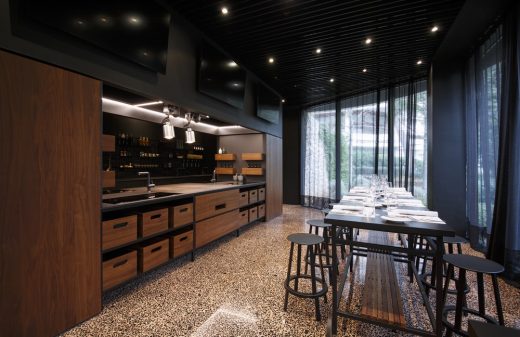
photo : Jure Živković
ResoLution Signature Restaurant Interior
Croatian hotel building by 3LHD Architects
Architect: 3LHD
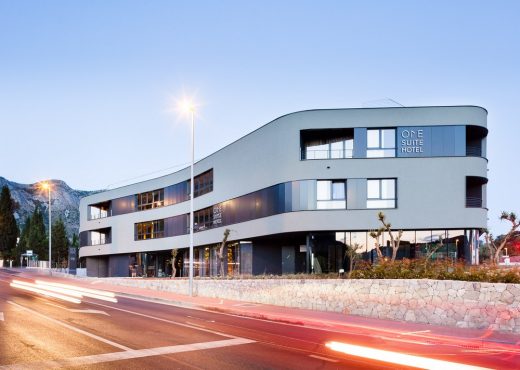
photograph : Marko Ercegović
One Suite Hotel Srebreno
Design: Studio RHE
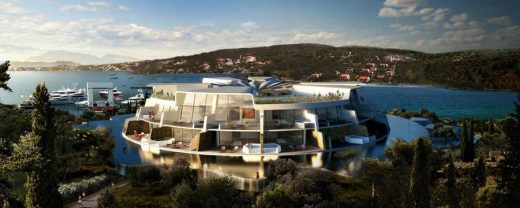
image from architects
Solta Island Resort – Rotating Hotel
Croatian Architecture – Selection
Comments / photos for the Campus Infobip, Zagreb designed by 3LHD page welcome

